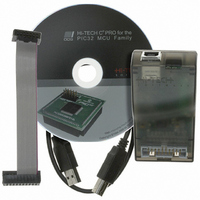SW500011 Microchip Technology, SW500011 Datasheet - Page 31

SW500011
Manufacturer Part Number
SW500011
Description
HI-TECH X PRO FOR PIC32
Manufacturer
Microchip Technology
Type
Compilerr
Series
PIC32r
Datasheet
1.SW500011.pdf
(440 pages)
Specifications of SW500011
No. Of User Licenses
1
Supported Families
PIC32
Core Architecture
PIC
Supported Hosts
Windows XP, Vista, Linux, Mac OS X
Software Edition
Professional
Kit Contents
Software And Docs
Tool Type
Compiler
Lead Free Status / RoHS Status
Not applicable / Not applicable
For Use With/related Products
PIC32 Series
Lead Free Status / Rohs Status
Lead free / RoHS Compliant
Other names
032
778-1007
778-1007
778-1007
778-1007
- Current page: 31 of 440
- Download datasheet (6Mb)
PICC32 Command-line Driver
With this part of the runtime startup code absent, the contents of uninitialized variables will be
unpredictable when the program begins execution.
with persistent. See Section
area of memory and are not altered by the runtime startup code in anyway.
2.3.2.3 System Coprocessor Initialization (--RUNTIME=cp0)
Initialise the system coprocessor. This includes clearing the Count register and status bits and ini-
tialising the Cause and EBase registers. It also includes any other initialisations performed by other
--RUNTIME sub-options. This behaviour is enabled by default.
2.3.2.4 General Purpose Register Intialization (--RUNTIME=gpr)
For the purpose of code generation some of the CPU general purpose registers are initialised with
special values, e.g. register 28 is used as a global data pointer and is initialised with an address in
the middle of KSEG0 DRM. This behaviour is enabled by default.
2.3.2.5 The Stack and Heap (--RUNTIME=stack, --RUNTIME=heap)
The allocation and size of the program stack and heap can be specified with the sub-options stack
and heap respectively. Both reserve memory for the these regions and the stack sub-option will
initialise the stack pointer (register 29) accordingly. By default both options are enabled. The default
behaviour is that both the stack and the heap are reserved the same area of memory as indicated by
the compiler generated psect heapstack. The stack grows down from the top of this psect and the
heap grows up from the bottom. The heapstack psect is allocated the largest available space in RAM
that is word aligned and divisible after all other data psects have been allocated.
of the stack or heap. Each argument is delimited by a colon. Valid arguments are as follows:
:num Specifies a specific size for the stack/heap in num number of bytes. Note that the stack/heap
:min:num Specifies the minimum number of num bytes the stack/heap must be.
:max:num Specifies the maximum number of num bytes the size of the stack/heap is restricted to.
If any kind of size restriction is placed on either or both of these regions then each is allocated its
own psect. Each psect will be as large as permitted by those restrictions. The stack psect will be
linked as high as possible and the heap psect will be linked as low as possible. The growth of the
stack and heap remains unchanged.
Variables whose contents should be preserved over a reset, or even power off, should be qualified
Arguments can also be provided to each of these sub-options that place restrictions on the size
is required to be word (i.e. 4 bytes) aligned and in units of words. Therefore any size specified
will be rounded down to the nearest whole word quantity.
3.3.10.1
for more information. Such variables are linked at a different
Runtime Files
31
Related parts for SW500011
Image
Part Number
Description
Manufacturer
Datasheet
Request
R

Part Number:
Description:
Manufacturer:
Microchip Technology Inc.
Datasheet:

Part Number:
Description:
Manufacturer:
Microchip Technology Inc.
Datasheet:

Part Number:
Description:
Manufacturer:
Microchip Technology Inc.
Datasheet:

Part Number:
Description:
Manufacturer:
Microchip Technology Inc.
Datasheet:

Part Number:
Description:
Manufacturer:
Microchip Technology Inc.
Datasheet:

Part Number:
Description:
Manufacturer:
Microchip Technology Inc.
Datasheet:

Part Number:
Description:
Manufacturer:
Microchip Technology Inc.
Datasheet:

Part Number:
Description:
Manufacturer:
Microchip Technology Inc.
Datasheet:










